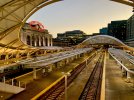Alon Levy has spent the
past ten years or so writing about how Amtrak's plans for upgrading the NEC always miss the low hanging fruit and end up with more expensive, less effective projects.
Really interesting thread!
Again, this is the importance of planning what service you want to see, the ideal timetables, routes, speeds, etc. Then you look at how you want to implement it.
Doing so puts you in a position of strength, because you can analyse each project based on its usefulness of bringing you to that point, rather than just building random stuff, some cheap, some expensive, with the hope of improving service.
The UK really struggles with this, HS2 is a step in the right direction, but little planning has been made in regards to possible improvements to regional service once the railway is operational. Whilst the new services will be able to mostly use existing track, branch lines or stations may need to be upgraded to facilitate this improved regional service. This is especially important in "classic-compatible" land, where tracks may need to be electrified, speeds increased or stations remodelled to facilitate the changing service.
Therefore, the US should start by determining how they want their system to look, then can focus on delivering the lowest-hanging fruit first (e.g. NEC upgrades, connecting city groups approx 100 miles apart) and determining the cheapest and easiest ways of achieving the desired level of service.
Initially freight corridors can be upgraded, with double tracks, passing loops, signalling and possibly electrification. These can begin operating services up to 100-110mph, covering intermediate towns and cities, along with limited-stop trains. A minimum standard of speed and frequency should be set for these routes, then if no suitable trackage can be found for this, then look at High Speed Rail.
I think the US would also benefit considerably from looking at DMUs or fixed formations (like Brightline) for their operations on these shorter/medium-distance routes. The endless shunting and splitting/reforming of coaching stock and different locomotives cannot be a efficient use of staff, stations or passengers time. At most, two fixed-formation sets should be linked/split (e.g. Liverpool/Norwich), as this can be done relatively quickly with a platform attendant and driver. Running shorter DMUs, more frequently, seems like a sensible way of providing a high quality service at a given cost. DMUs can still achieve speeds of 125mph, so would be a fantastic starting point for many of these routes.
Once the route in question attracts more riders, then look at improving speeds on existing freight corridors (tri/quad track to separate passenger trains from freight trains to allow for increased speeds) and electrifying. If increasing speeds and capacity on freight corridors is beginning to provide diminishing returns (as improving existing alignments has in the UK), then look at building high speed rail routes.
Whilst the focus is probably best to not be on long distance right now, in terms of creating a more useful network, improvements to key corridors of cities 1-200 miles apart will inevitably help with speeding those trips up.
For example, improving the Keystone Corridor and improving Pittsburgh/Cleveland/Chicago on their own merits of regional connectivity, will massively improve journey times on the Capitol Limited train, perhaps to the extent that more people may consider using it. Reducing journey times from 17 hours to say 10, could allow Amtrak to run a sleeper service that is mostly overnight, along with a few through day services, serving the intermediate cities.
(Update)
Also want to add you should totally consider rolling stock and infrastructure as one. Completely agree with this part of the blog about the new Avelia trains:
The whole notion of buying quicker trains for the NEC is ridiculous– the existing Acela Express trains have plenty of oomph (16 kW/tonne) to do anything they need to do. “Lighter” and “faster” isn’t the key to anything on the NEC, and dropping in a higher-performance train will not lead to material trip time improvements. They need to speed up the slow bits first, which isn’t something you do by blowing money on trains.


